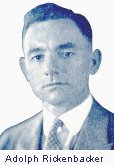Electric Guitar History
The Birth of the First Electric Guitar
The most important component in electric guitar history was, of course, advances in the understanding of elctricity and electro-magnetic theory. This critical physical phenomenon made possible many advances such as electric lights, electric motors, etc. Without it there would have been no electric guitar.
Electric Guitar History - Enter Electricity...
After being fired by National String Instrument Company, George Beauchamp
(pronounced "Beachum") began looking for other ways to increase the volume of the
guitar. By this time it was well known that passing a wire through a magnetic field
would induce an current in the wire and, therefore, an electric field around the wire.
If the wire was vibrating, this would produce an alternating current(in other words, the direction of
the current would flip flop as the wire vibrated back and forth) and, as a consequence, the direction
of the electric field produced would also alternate. This was a critical component in the beginnings
of electric guitar history.
Note this phenomenon was well understood and was the basis of the
operation of electric motors, phonograph needles, etc. Beauchamp realized that if this principle
could be applied to steel guitar strings and, that if a device could be constructed that could
pick up the vibrations of the strings individually, the vibrations could be converted to an
electric current that could be sent to and amplified by one of the tube type amplifiers that
were currently being used by the PA and radio systems of the day. This would successfully amplify the guitar.
The Frying Pan

Once the pickup was working, Beachamp contacted Harry Watson, a talented craftsman and colleague from National String. Together they created the first working prototype, dubbing it "The Frying Pan". From the photo you can see where the name came from.
Adolf Rickenbacker

30 Day FREE TRIAL!








New! Comments
Have your say about what you just read! Leave me a comment in the box below.